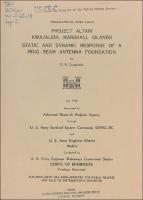Please use this identifier to cite or link to this item:
https://hdl.handle.net/11681/20705| Title: | Project ALTAIR, Kwajalein, Marshall Islands : static and dynamic response of a ring-beam antenna foundation |
| Authors: | United States. Army. Corps of Engineers. Mobile District United States. Army. Sentinel System Command United States. Advanced Research Projects Agency Casagrande, Dirk R. |
| Keywords: | ALTAIR (Project) Antenna towers Radar antennas Tower foundations Vibration |
| Publisher: | U.S. Army Engineer Waterways Experiment Station. Engineer Research and Development Center (U.S.) |
| Description: | Miscellaneous Paper Abstract: ALTAIR is an experimental radar installation. Its 150-ft-diam antenna dish is supported by a four-legged frame that rotates on a 118-ft circular track. The track is centrally located on a 9-ft-wide ring-beam foundation. Four radial ribs and a cable tunnel connect to the beam and act as stiffeners. The subsurface materials in the area consist of coral sand and rock. The antenna dish operates in two modes: elevation (vertical) and azimuth (horizontal). The elevation is changed by rotating the dish about a horizontal axis passing through the base of the dish, and the azimuth of the dish is varied by rotating the entire support frame. The accuracy of a radar installation is sensitive to the antenna foundation response under both static and dynamic loadings. Due to the unique design of the ALTAIR structure, it was decided to monitor the static and dynamic responses of its ring-beam foundation to ascertain if the foundation met operational specifications. The settlement of the beam was monitored from February 1967 through April 1968 during the period of dead load application resulting from construction of the antenna superstructure. By 10 April 1968, the foundation had settled an average of 0.049 in. and had tilted almost as a plane toward the adjacent operations building. This tilt was 0.026 in. for the 118-ft track. The rate of settlement, which was almost constant at 0.0037 in. per month during the dead load application, started decreasing in January 1968, at which time the rate of dead load application was reduced. The dynamic foundation response, consisting of transient (elastic) deflections and vibration frequency and amplitude, was recorded in February 1968 during the initial antenna testing program. The maximum transient (elastic) deflection of the beam was 0.0088 in. at a point halfway between two of the ribs, and the minimum elastic deflection was 0.0044 in. at the cable tunnel connection. The data indicated that the beam was bending outward as any of the four bogies supporting the frame passed any of the points monitored. The angle of this bending at any location was independent of which bogie passed the point and was a maximum of about 8 sec halfway between two of the ribs. At this angle of twist, the outside edge of the beam was deflected about 0.004 in. more than the inside edge. The foundation vibration was monitored in three modes: radially, tangentially, and vertically to the circular foundation. The main frequency of response in all three modes was 21 Hz (cps). Frequencies as low as 10 Hz were recorded in the tangential mode, but these vibrations usually lasted for only a few cycles. The stiffening effect of the cable tunnel increased the tangential frequency at this point to an average of 30 Hz. Very high-frequency vibrations (130 to 170 Hz) of relatively minor amplitude were superimposed on the lower frequencies at azimuth rotation rates greater than about half the design rate. The rate at which the azimuth drive gear was engaging the drive-rail teeth was occasionally the same as the recorded foundation frequency when this rate was less than 21 Hz. The maximum amplitude of foundation vibration was in the vertical mode. The maximum recorded vibration was 0.0007 in. peak to peak, which was caused by maximum azimuth deceleration from a rotation rate slightly greater than design rate. The amplitude of vibration was generally less than 0.0001 in. peak to peak except during acceleration, deceleration, or at azimuth rotation rates greater than about half the design rate. During constant-rate azimuth rotation with constant elevation, the maximum foundation vibration occurred at a rotation rate slightly less than design rate. Operation in the elevation mode only (constant azimuth), although this mode was not fully operational at the time of these tests, created foundation vibrations of relatively minor amplitude with respect to those resulting from azimuth rotation. |
| Rights: | Approved for public release; distribution is unlimited. |
| URI: | http://hdl.handle.net/11681/20705 |
| Appears in Collections: | Miscellaneous Paper |
Files in This Item:
| File | Description | Size | Format | |
|---|---|---|---|---|
| MP-S-68-14.pdf | 14.39 MB | Adobe PDF |  View/Open |